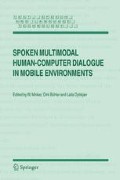Abstract
Multimodal systems are moving to the centre-stage of dialogue research, reflecting the maturing of component technologies and the recognition that “interface” per se may not be the best way to describe the functionality of such systems. Rather they are emerging as full communications systems, with a corresponding rich set of expressive capabilities.
Access this chapter
Tax calculation will be finalised at checkout
Purchases are for personal use only
Preview
Unable to display preview. Download preview PDF.
References
Beskow, J., Edlund, J., and Nordstrand, M. (2004). A model for multimodal dialogue system output applied to an animated talking head. In Minker, W., Bühler, D., and Dybkjær, L., editors, Spoken Multimodal Human-Computer Dialogue in Mobile Environments. Kluwer Academic Publishers, Dordrecht, The Netherlands. (this volume).
Bühler, D. and Minker, W. (2004). A reasoning component for information-seeking and planning dialogues. In Minker, W., Bühler, D., and Dybkjær, L., editors, Spoken Multimodal Human-Computer Dialogue in Mobile Environments. Kluwer Academic Publishers, Dordrecht, The Netherlands. (this volume).
Furui, S. (2004). Speech recognition technology in multimodal/ubiquitous computing environments. In Minker, W., Bühler, D., and Dybkjær, L., editors, Spoken Multimodal Human-Computer Dialogue in Mobile Environments. Kluwer Academic Publishers, Dordrecht, The Netherlands. (this volume).
Macherey, K. and Ney, H. (2004). Feature functions for tree-based dialogue course management. In Minker, W., Bühler, D., and Dybkjær, L., editors, Spoken Multimodal Human-Computer Dialogue in Mobile Environments. Kluwer Academic Publishers, Dordrecht, The Netherlands. (this volume).
Tamura, S., Iwano, K., and Furui, S. (2004). A robust multimodal speech recognition method using optical flow analysis. In Minker, W., Bühler, D., and Dybkjær, L., editors, Spoken Multimodal Human-Computer Dialogue in Mobile Environments. Kluwer Academic Publishers, Dordrecht, The Netherlands. (this volume).
Author information
Authors and Affiliations
Editor information
Editors and Affiliations
Rights and permissions
Copyright information
© 2005 Springer
About this chapter
Cite this chapter
Rudnicky, A.I. (2005). Multimodal Dialogue Systems. In: Minker, W., Bühler, D., Dybkjær, L. (eds) Spoken Multimodal Human-Computer Dialogue in Mobile Environments. Text, Speech and Language Technology, vol 28. Springer, Dordrecht. https://doi.org/10.1007/1-4020-3075-4_1
Download citation
DOI: https://doi.org/10.1007/1-4020-3075-4_1
Published:
Publisher Name: Springer, Dordrecht
Print ISBN: 978-1-4020-3073-4
Online ISBN: 978-1-4020-3075-8
eBook Packages: Computer ScienceComputer Science (R0)

